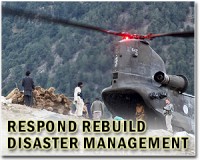 |
Leogane, Haiti (AFP) Feb 18, 2011 Residents of the seaside Haitian town of Leogane, which was largely destroyed by the January 2010 earthquake, would love to rebuild, but first they have to get past the mounds of rubble. The good news, if you can call it that, is that engineering assessments conducted by the government and the United Nations show only about 50 percent of Leogane's buildings collapsed, unlike the 80-90 percent some feared. The bad news: three-story houses are waist-high, flattened into the ground. Thirteen months after the quake, concrete and cinder blocks still lurk around every corner. Removing the rubble in Leogane has been easier than in the congested, teeming capital Port-au-Prince, but even here, it's taking much, much longer than anyone expected. Alexis Santos, the larger-than-life local mayor, told AFP that reconstruction money is finally starting to arrive. "I'm hoping that pretty soon, Leogane will be better," he says. "It won't be California. But, you know, it will be better." On Monday, he met with Rebeca Grynspan, associate administrator of the United Nations Development Program. UNDP recently launched a rubble removal project in Leogane, after other high-profile rubble projects in Port-au-Prince met long delays. Grynspan told Santos, "In many places, it's difficult to organize. You had the local organization to make the decisions." Municipal support has turned out to be the key issue for rubble removal. Organizations need legal approval to tear down houses, as well as land for the rubble once it's been removed. Grynspan is also the UN representative to the Interim Haiti Recovery Commission, which holds the purse strings to international aid money offered after the catastrophic January 2010 quake that killed over 220,000 people. In August, the commission approved a $17 million UNDP rubble removal project in and around Carrefoure Feuille in the capital. They will only start clearing rubble on Monday. For months, the program could not secure land to move the debris. Funding was slow to arrive. Legal issues also dogged the initiative. Removing rubble is not as simple as identifying a collapsed house and carrying it away. Some renters were on public land. "That's why the progress is slow in itself, you have to deal with the legal issues. We are bringing in experts from Gaza and Lebanon, now," explained Grynspan. Buildings across the earthquake-affected area are being labeled red, yellow and green by government engineers, who make safety assessments. "Red" means a house is too dangerous to enter, "yellow" means the building is damaged and access should be very limited, "green" means safe. Building owners and residents are fearful that when trucks arrive, organizations will tear down houses based on the labels alone. Kit Miyamoto, a structural engineer and president of Miyamoto International, Inc., worked in conjunction with the Pan-American Development Foundation to launch the housing assessments, ultimately training hundreds of Haitian engineers. In an email to AFP, Miyamoto noted, "From our field experience, about 50% of yellow houses are occupied for 24 hours a day." The other 50 percent are occupied during the daytime. "They have nowhere to go," he said. "And people don't like camps because of the security and disease risks." International organizations tread carefully and create a legal agreement for every house they demolish. For now, nothing is being demolished without permission. In Leogane, collapsed buildings are torn apart with a mix of manual labor and heavy machinery. Hundreds of local workers in the Cash-for-Work program wield pickaxes and sledgehammers. Young men do most of the hard labor, and women shuttle back and forth, filling up one plastic bucket at a time. Trucks crisscross town and dump hundreds of cubic meters of concrete in an ever-growing landfill, which has a high fence around its perimeter to prevent people from dumping trash. Project manager George Tadros told AFP he believes other organizations in Leogane are stealing their rubble at demolition sites and using it to fill in roads or driveways. In a sea of rubble, it's hard to believe the debris has any value at all. But transforming a massive block to portable pieces is an expensive endeavor. It may be years before Leogane removes all the rubble and gets a real chance to start over. For now, Santos says, the UNDP program is inspiring some hope. "They see activity. They see dump trucks going in. They see they're not joking around."
Share This Article With Planet Earth
Related Links Bringing Order To A World Of Disasters A world of storm and tempest When the Earth Quakes
 Australia flags taxpayer levy for floods
Australia flags taxpayer levy for floodsSydney (AFP) Jan 21, 2011 Australian Prime Minister Julia Gillard Friday raised the prospect of a one-off tax to pay for rebuilding after epic floods, as rising waters prompted more evacuations in the southeast. Crops, roads and railway lines were washed away and thousands of homes destroyed by vast floods that swamped Queensland state this month in what the government has said could be the nation's most costly natur ... read more |
|
| The content herein, unless otherwise known to be public domain, are Copyright 1995-2010 - SpaceDaily. AFP and UPI Wire Stories are copyright Agence France-Presse and United Press International. ESA Portal Reports are copyright European Space Agency. All NASA sourced material is public domain. Additional copyrights may apply in whole or part to other bona fide parties. Advertising does not imply endorsement,agreement or approval of any opinions, statements or information provided by SpaceDaily on any Web page published or hosted by SpaceDaily. Privacy Statement |